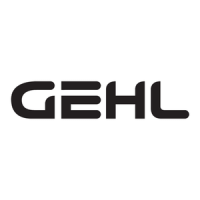913225/CP0807 58 PRINTED IN U.S.A.
B1 - DRY AIR FILTER CARTRIDGE
CHECK - CLEAN
In case of use in a very dusty atmosphere, there are
pre-filtration cartridges (see chapter: 6 - MAINTE-
NANCE: FILTER CARTRIDGES AND BELTS).
Also, the checking and cleaning period of the cartridge
must be reduced.
IMPORTANT: If the clogged filter indicator light
comes on, this operation must be carried out as
quickly as possible (1 hour maximum). The car-
tridge must not be cleaned more than seven
times, after which the cartridge must be changed.
- For the disassembly and reassembly of the cartridge,
see chapter: 6 - MAINTENANCE: D3 - DRY AIR
FILTER CARTRIDGE.
- Clean the filter cartridge using a compressed air jet
(max. pressure 30 psi (2 bar) directed from the top to
the bottom and from the inside toward the outside at
a minimum distance of 1 inch (25 mm) from the car-
tridge wall.
- Cleaning is completed when there is no more dust
on the cartridge.
IMPORTANT: Keep the safe distance of 1 inch
(25 mm) between the air jet and the cartridge to
avoid tearing or making a hole in the cartridge.
The cartridge must not be blown out near the air
filter box. Never clean the cartridge by tapping it
against a hard surface. (Protect your eyes during
this procedure.)
- Clean the cartridge seal surfaces with a damp, clean
lint-free cloth and grease with a silicone lubricant.
- Visually check the outer condition of the air filter
and its mounts. Also verify the condition of the
hoses and their connections.
IMPORTANT: Do not clean the dry air filter car-
tridge by washing it. Do not clean the safety car-
tridge located inside the filter cartridge. Instead,
replace it if it is dirty or damaged.
- Telescope the boom several times in order to spread
the grease evenly.
- Remove any excess grease.
IMPORTANT: If the telescopic handler is used in
an abrasive environment (dust, sand, coal…), use
lubricating oil instead. Consult your dealer.
A8 - GENERAL MACHINE OPERATION
AND CONDITION
CHECK
Are any decals missing or damaged? Are all guards,
shields and covers in place? Do all controls function
smoothly and properly? Are there any abnormal vibra-
tions or noises? Are any hose or fitting connections
leaking? Is the engine exhaust color normal?
WARNING
Manufacturers of push-pull control cables
advise taking the following operation and
maintenance precautions:
Do not adjust the control cable with the engine
running.
A gradual or sudden increase in the no-load
friction (cable disconnected at both ends) of a
control cable is an indication of an impending
or present performance problem. The control
cable should be replaced.
A gradual or sudden decrease in the useable
travel is a indication of an impending or pre-
sent performance problem. The cable should
be replaced.
Control cables that have moisture inside of
them and/or have frozen should be replaced.
Do not apply heat to thaw or dry control
cables.
Control cable are lubricated for the life of the
control cable. Do not remove the seals or
lubricate the control cable.
Control cables are designed to be non-
repairable. Do not attempt to repair control
cables.
Failure to heed could result in death or seri-
ous injury.
B - EVERY 50 HOURS OF
SERVICE
Perform the operations described previously as well
as the following operations:
Courtesy of CraneMarket.com

